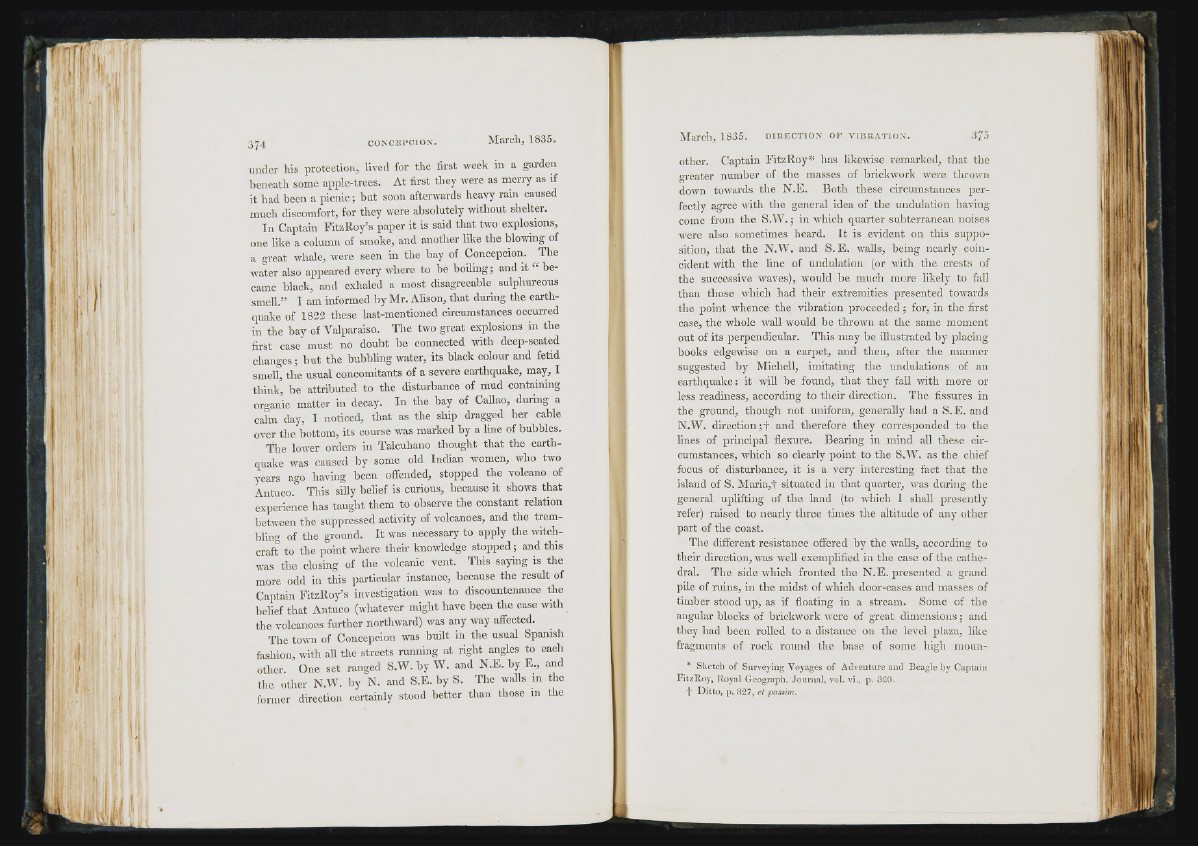
M
r i -H * '
t ' '
I f :
J )
under his protection, lived for the first week in a garden
beneath some apple-trees. At first they were as merry as if
it had been a picnic ; but soon afterwards heavy ram caused
much discomfort, for they were absolutely without shelter.
In Captain FitzRoy’s paper it is said that two explosions,
one like a column of smoke, and another like the blowing of
a great whale, were seen in the hay of Concepcion. The
water also appeared every where to be boding ; and it “ became
black, and exhaled a most disagreeable sulphureous
smell.” I am informed by Mr. Alison, that during the earthquake
of 1822 these last-mentioned circumstances occurred
in the bay of Valparaiso. The two great explosions in the
first case must no doubt be connected with deep-seated
changes; hut the bubbling water, its black colour and fetid
smell, the usual concomitants of a severe earthquake, may, I
think, be attributed to the disturbance of mud containing
organic matter in decay. In the hay of Callao, during a
calm day, I noticed, that as the ship dragged her cable
over the bottom, its course was marked by a hne of hubbies.
The lower orders hi Talcuhano thought that the earthquake
was caused by some old Indian women, who two
years ago having been offended, stopped the volcano of
Antuco. This silly belief is curious, because it shows that
experience has taught them to obsen-e the constant relation
between the suppressed activity of volcanoes, and the trembling
of the ground. It was necessary to apply the witchcraft
to the point where their knowledge stopped ; and this
was the closing of the volcanic vent. This saying is the
more odd in this particular instance, because the result of
Captain FitzRoy’s investigation was to discountenance the
belief that Antuco (whatever might have been the case with
the volcanoes further northward) was any way affected.
The town of Concepcion was built in the usual Spanish
fashion, with all the streets running at right angles to each
other. One set ranged S.W. by W. and N.E. by E., and
the other N.W. by N. and S.E. by S. The walls in the
former direction certainly stood better than those in the
other. Captain FitzRoy* has likewise remarked, that the
greater number of the masses of brickwork were thrown
down towards the N.E. Both these circumstances perfectly
agree with the general idea of the undulation having
come from the S .W .; in which quarter subterranean noises
were also sometimes heard. It is evident on this supposition,
that the N.W. and S. E. walls, being nearly coincident
with the line of undulation (or with the crests of
the successive waves), would be much more likely to fall
than those which had their extremities presented towards
the point whence the vibration proceeded; for, in the first
case, the whole wall would be thrown at the same moment
out of its perpendicular. This may be illustrated by placing
books edgewise on a carpet, and then, after the manner
suggested by Michell, imitating the undulations of an
earthquake: it will be found, that they fall with more or
less readiness, according to their direction. The fissures in
the ground, though not uniform, generally had a S.E. and
N.W. direction;! and therefore they corresponded to the
lines of principal flexure. Bearing in mind all these circumstances,
whioh so clearly point to the S.W. as the chief
focus of disturbance, it is a very interesting fact that the
island of S. Maria,! situated in that quarter, was during the
general uplifting of the land (to which 1 shall presently
refer) raised to nearly three times the altitude of any other
part of the coast.
The different resistance offered hy the walls, according to
their direction, was well exenqilified in the case of the cathedral.
The side which fronted the N .E . presented a grand
pile of ruins, in the midst of which door-cases and masses of
timber stood up, as if floating in a stream. Some of the
angular blocks of brickwork were of great dimensions; and
they had been rolled to a distance on the level plaza, like
fragments of rock round the base of some high moun-
* S k e tc h o f S u rv e y in g Vo}'ages o f A d v e n tu re a n d B e ag le b y C a p ta in
I 'itzR o y , R o y a l G e o g ra p h . .Tournal, vol. v i., p . 320.
! D itto , p . 327, et passim.